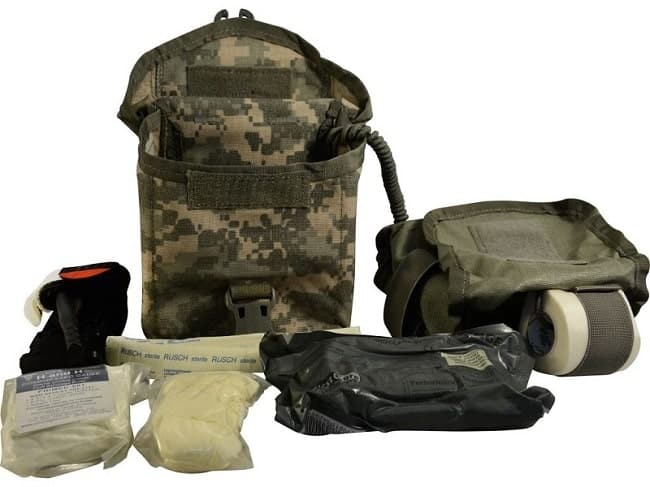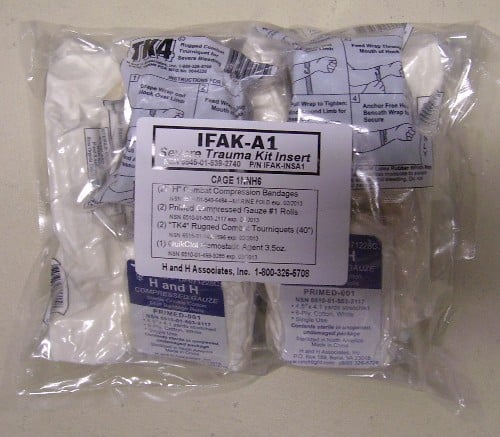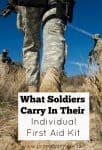A significant EMP disaster has just struck. With the grid down, the masses are left without a way to resupply their food, no running water, and in a state of panic.
Chaos ensues, and, as predicted, the masses take to the streets to loot and riot. Anyone who gets in their way is likely to get shot, stabbed, or trampled to death. If the hospitals are still operating, there will be so much chaos that it would take a miracle to see a real doctor…
What do you do?
Let’s hope that a situation like this never happens to you (though the people of Bosnia, Syria, Georgia, Somalia, and so forth will quickly tell you how quickly things can go from “normal” to SHTF).
But, if the S really does HTF, your standard first aid kit meant to treat scrapes and scratches is NOT going to cut it!
This is where an IFAK comes into play.
IFAK stands for Individual First Aid Kit, and the military issues them to soldiers going into battle.
Even though the IFAK contents vary depending on the military branch (Army, Marine Corps, US Air Force…) and where the soldier is being deployed (Iraq, Afghanistan…), they all cover the same most common deadly injuries.
Why You Might Want an IFAK Kit
In the past few years, it has somehow become cool to wear a bunch of camo, buy Army surplus gear, and flaunt it around to show what a bad@$$ you are.
Let’s be clear here: There is nothing “cool” about carrying an IFAK around with you unless we are talking about how “cool” it is to be responsible.
An IFAK will be completely useless for more than 99% of what people mostly have to deal with.
An IFAK is not going to treat a boo-boo.
An IFAK won’t help your migraine go away.
An IFAK won’t protect your feet from blisters…
And so on.
Remember, IFAK contents are chosen to treat the most common deadly injuries in battle. Those injuries are:
- Serious Hemorrhaging
- Inadequate airway
When might you need to worry about Deadly Hemorrhaging or Inadequate Airways?
Here’s just a few that I can think of off the top of my head.
- To be prepared for active shooter situations
- When hunting
- At the firing range
- Anywhere else that a firearm might be discharged
- If you live in a rural area and medical help might not be able to arrive quickly
- If you use chainsaws or other machinery that can cause significant injuries
- If you want to be prepared for whatever disaster may come!
IFAK Contents
The Army, Marines, and Air Force all issue IFAK, and the contents are different in each.
The Army has also updated its IFAK kits a couple times.
Military from other countries also issue IFAK kits too, and those IFAK contents might not match what the USA gives out.
Here are the latest versions of the Army, Air Force, and Marine Corp IFAK contents.
US Army Improved First Aid Kit II

In the US Army case, “IFAK” stands for “Improved First Aid Kit.” That Improved FAK was issued in 2006.
In 2014, the Army updated it to the IFAK II by adding several more items. (all links go to product on Amazon)
- Two Combat Application Tourniquet
- Six Inch Israeli Pressure Bandage: The bandage acts as many types of bandages in one. It has a sterile, non-adhesive pad that can act as a primary dressing. It can be easily wrapped, so acts as a secondary dressing. It is elastic, which means that it applies pressure and acts as a tourniquet over the wound site. The easy closure means it can be used very quickly for situations where “every second counts” and can even be applied by the victim with just one hand.
- Gauze Bandage: Gauze bandage is used to dress wounds in the field. The Improved Army First Aid Kit II includes a 100 count of 4 ½ inch gauze bandages.
- Surgical Tape: The IFAK surgical tape is 3 inches wide and comes in a 10-yard roll. It is used to apply dressings over the skin.
- Nasopharyngeal Airway Tube: As mentioned before, one of the most common battlefield deadly injuries is inadequate airway. The soldier may stop breathing because of shock, trauma, wounds to the mouth or chest… When this happens, the airway tube is inserted. You can read about how to insert an airway tube
- Gloves: Wear gloves when treating injuries to reduce the risk of infection.
- Tactical Combat Casualty Card: So you can write down what type of first aid was given to the wounded soldier
- Sharpie: Permanent marker for writing on the casualty card or the tourniquet
- An Eye Shield
- Chest Seals: This is a rubber seal with a valve on it so chest wounds can be sucked out
- Strap Cutter
US Air Force IFAK
The US Air Force IFAK focuses on wound management. The entire IFAK contents with the bag weigh 1.6 pounds. It includes:
- Israeli Pressure Bandage – read Israeli bandage vs tourniquet
- Gauze Bandage: Also called Crinkle Cotton
- Self Adherent Bandage 3” x 5 yards
- Triangular Bandage: 46 x 46 x 52 inches
- Lip Balm
- QuikClot Package
- EMS Shears
- Adhesive Tape, 1” x 10 yards
- Tourniquet – Read how to use a tourniquet.
- Pair of Nitrile Gloves
- Nasopharyngeal Airway Tube
- Surgical tape, 1” by 10 yards
USMC IFAK

- Two Self-Application Tourniquets, 40”
- Two Compression Bandages: 8 x 10 inches
- Two Compressed Gauze:5 inches by 4.1 yards
- Five Adhesive Bandages: 2 x 4 ½ inches
- 10 Adhesive Bandages: ¾ by 3 inches
- Two Triangular Bandages: 40 x 40 x56 inches
- Combat Reinforcement Tape: 2x 100 inches; this tape secures bandages in place and also reinforced compression to stop blood loss
- QuikClot Combat Gauze: Contains a hemostatic agent which stops blood loss quickly. Put the gauze directly over the wound and apply pressure.
- Water-Jel Burn Dressing: 4 x 16 inches
- Bacitracin Antibiotic Ointment: 0.9 grams
- Povidone-Iodine Topical Solution USP 10% 1/2 fl. Ounce
- Water Purification Tablets
Should You Buy an IFAK?
You can buy military IFAK kits online at a lot of stores. Be warned that they are relatively pricey (sometimes over $100). The contents might also be EXPIRED!
Rather than wasting your money on a pricy IFAK kit just because it happens to be the same one issued by the military, why not just build your own?
You’ll have a lot more room to add the items you need for everyday injuries and disasters, so you’ll be prepared for everything and not just the worst-case scenarios.
Here’s a complete first aid checklist for your home, a smaller wilderness first aid kit checklist, and a Bug Out Bag first aid checklist.
But that’s just my take on it. What do you think about buying Military IFAK kits?



The eventuality of it all would be, I packed some Chest Seals and an ARS Decomp needle, Maybe 80% of the people will not know how to use them properly, however, lets just say there was a combat medic nearby and was available ? now there is more chance of a life being saved because someone thought ahead.. Carry what you can, carry what you think just might save your life.
There are really two kits, one is a blow-out kit for gunshot wounds. The other is a boo – boo kit for everything else. The everything else kit should expand and contract for the activity the kit will be at or used for. If this doesn’t happen and you just keep adding supplies to accomodate every eventuallity, you will not be able to lift or carry it outside your vehicle. Some protocols allow for first aid only. This means if you don’t have the training to do the skill, don’t put it in the kit. If you are hoping that someone else’s trained skill might be there at the time of incident and you are carrying it in hopes they can use it, up to you. Ounces are pounds, miles down the road. Pack your kits accordingly. And lastly, Train, Train, Train.
Very good point about not packing items you don’t know how to use. I often see things like suture kits and chest seals on first aid kit lists and most people would do more harm than good with these items. It’s a hard balance to get in all those items without weighing yourself down too much.
I found an expired IFAK at an Army Navy store for $20. I use the contents for training and bought a new one with the same contents for actual use.
A IFAK should contain the following items. Two hyphen chest seals for bullet wounds to the chest area, they prevent the chest from sucking in air and keeping the lungs from expanding, a sucking chest wound. Second, should be a good catt tourniquet from a good name manufacturer because of reliability issues, cheap ones break and are useless, the rule for use is 2-3″ above the wound but not on a joint. Third, should be an Israelie wound bandage. They are great for covering wounds and applying pressure to the wound at the same time. Forth, should be gauze, either z folded packing gauze or celox hemostatic wound packing gauze, gauze that is impregnated with the blood clotting material, it will make the blood clot faster and stop the bleeding with the application of pressure to the wound. They also make celox powder granules will make the blood clot faster than pressure alone, even in patients who are on blood thinners. for the same reason, apply the granules to the wound and then apply pressure with gauze to stop the bleeding. Fifth, you will need nitril gloves to avoid the spread of germs and to protect those who may be allergic to latex. Sixth, standard rolled gauze for applying pressure to the wound as well as wrapping the wound to keep it clean and still applying pressure at the same time, untill medical help arrives. Seventh, a good pair of medical scissors or shears, for cutting away clothing to access the wound area or cutting off any binding items such as rings or watches or belts. You must be able to access the wound area to treat it. These are by no means the only way to go but are the rules that I use in my IFAK. You can buy premade ones from reputable companies or you can make your own to suit your personal needs. The important thing is to be familiar with your kit and know how to use each item in it, and to have it on your person or readily aavailable so you can access it quickly when the time comes you need it.
Good article on preparedness. Your IFAK should be customized to your potential risks. In trauma situations it is critical to be prepared to stop bleeding, restore breathing and provide basic life services. Follow the Stop the Bleed protocols in addition to basic first aid.
The US Army kit does not have Quick Clot in it due to storage issues they are issued as a separate Item and carried in the kit so it is easier to track expiration dates.
Hey Joseph – thanks for the clarification on that, did it change recently?
Great info – thanks! I would also suggest that you take a first aid course from a reputable source so that you understand when and how to use the IFAK. The Good Samaritan Law will protect you, but only to a point. When it truly counts, you should not be experimenting or guessing. Keep a kit in easy-to-access places like your home, car, office, RV, and others. Where feasible, add a full trauma kit to help increase that “golden window” between injury and professional help. Just my two cents. Be safe!
Excellent advice dB1 – we have a good post on first aid courses here
I get sprains more frequently than average, so an ACE bandage — 4″ wide that can do double duty with knees or, doubled over, with ankles — and a pump up walking ankle splint brace (they prevent lateral movement that exacerbates the sprain while allowing for supported walking that encourages healthy blood flow and healing) are a must for me. I can, with enough product, tape it in a pinch but these two products are useful enough to more than justify their weight and packing space.
Good additions for sure. Thanks for stopping by Marla.
The list early in the article will treat boo-boos (bandaids & neosporin), vascular headaches (NSAIDS — I pack both naproxen sodium and ibuprofen), and the moleskin will protect your feet from blisters. It’ll treat major wounds, too. Great list!
TX is totally correct! Practice, practice, practice using bandages, etc. to build the muscle memory for when supplies are needed. Also one may purchase military Field Manuals to learn proper application of med supplies. Most FM’s are repetitive, there’s a reason…to retain the information. Most importantly practice using as well as mental preparedness. Things can get messy quickly.
If you’ve never used some, or all, of the IFAK supplies I *strongly* suggest you buy an extra one or two pieces of the primary components. Open the package, read the directions, handle the product, read up on how to use it, watch some You Tube videos, etc.
IOW, acquaint yourself and others with the product *before* you have to use it IRL.
Great point TX. I think we are all guilty of not testing our gear and practicing our skills BEFORE they are needed.
This is the most comprehensive and helpful article I’ve ever read on the subject. I’m almost completely clueless when it comes to this subject matter and it is beyond helpful. The links to amazon for purchases make is (almost too) easy. Thanks so much.